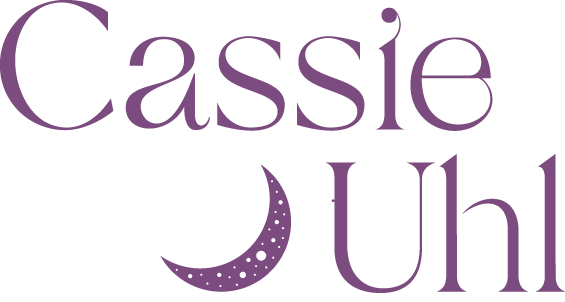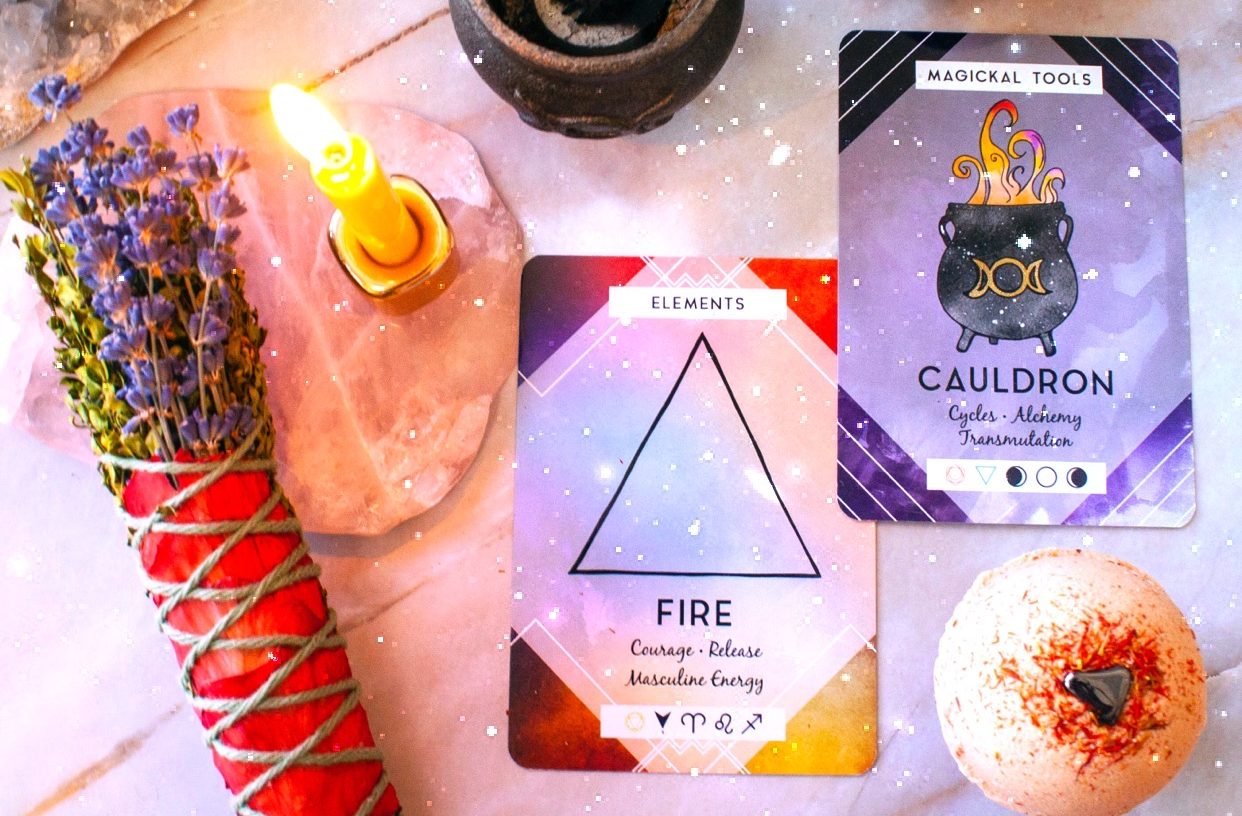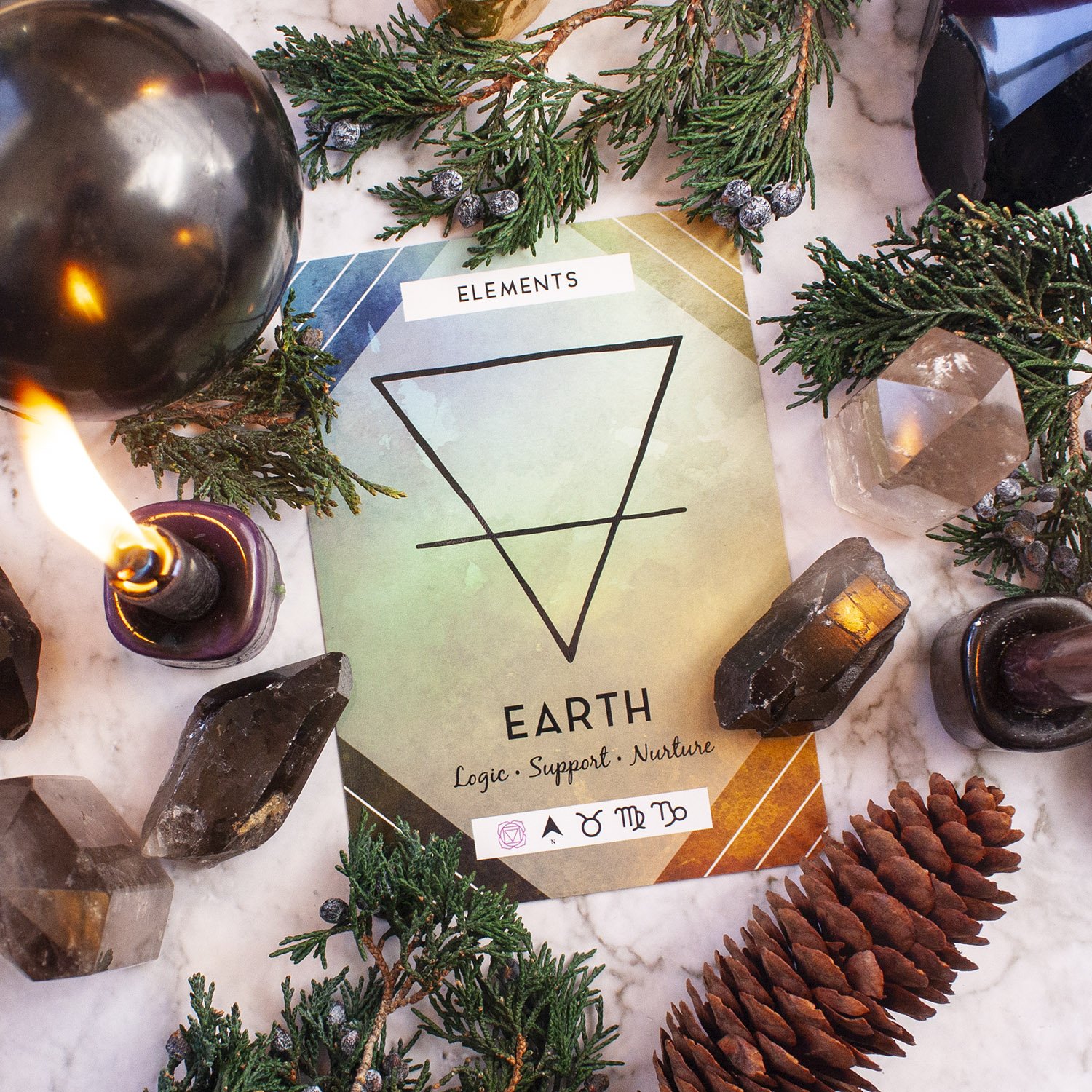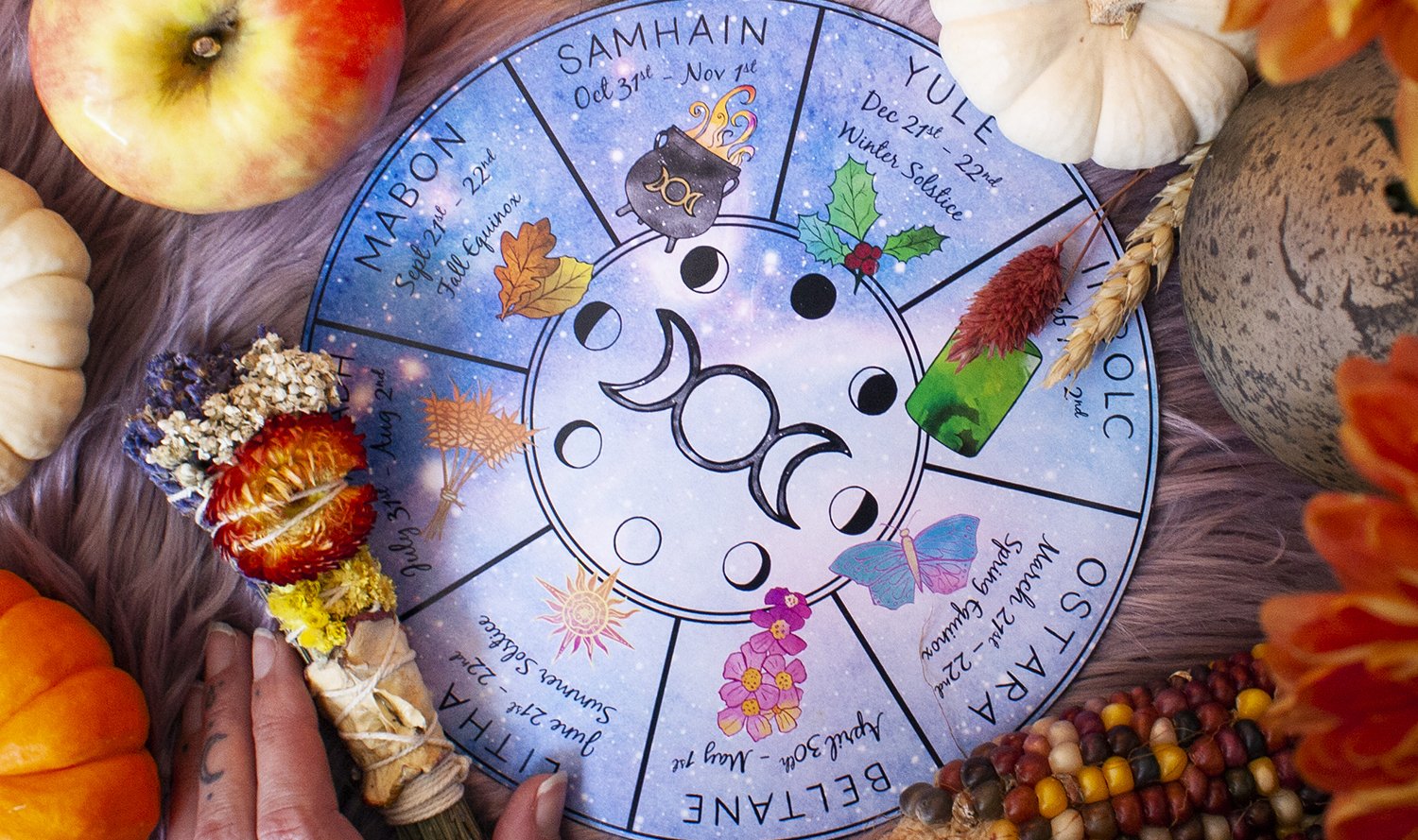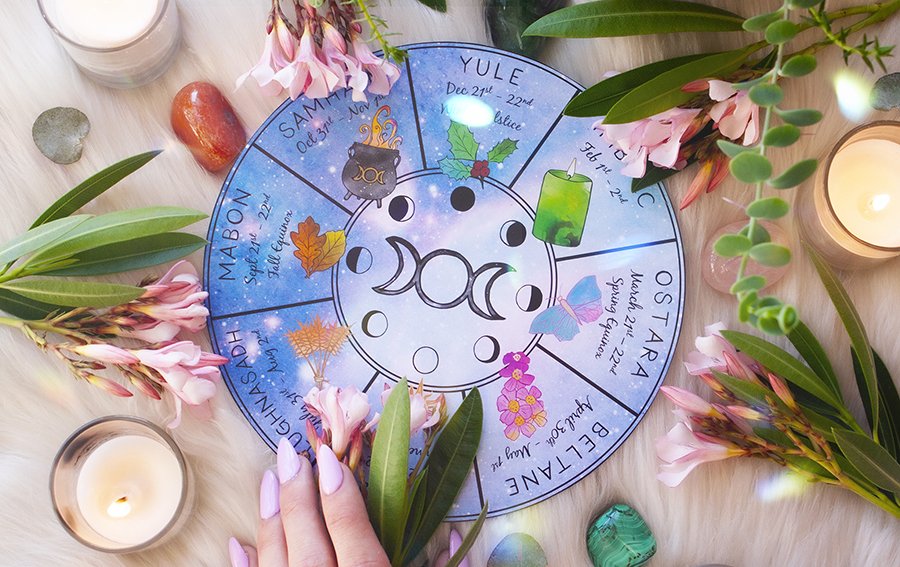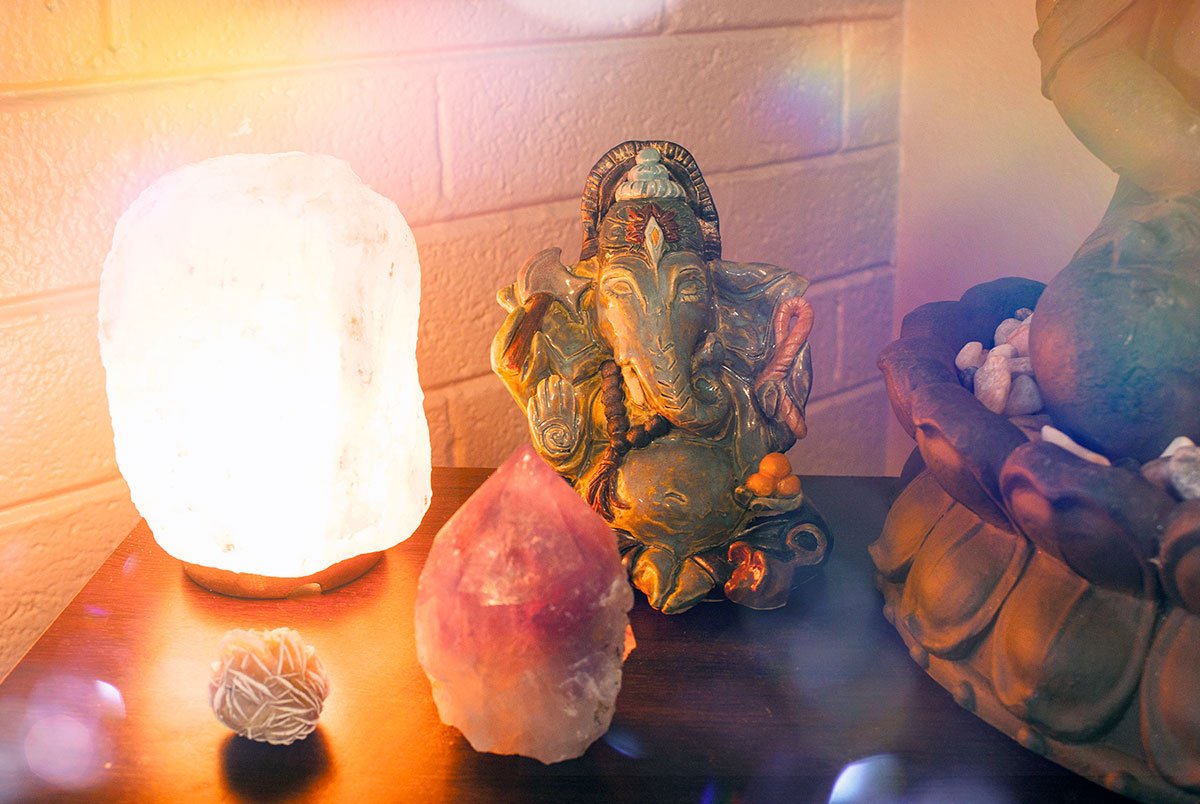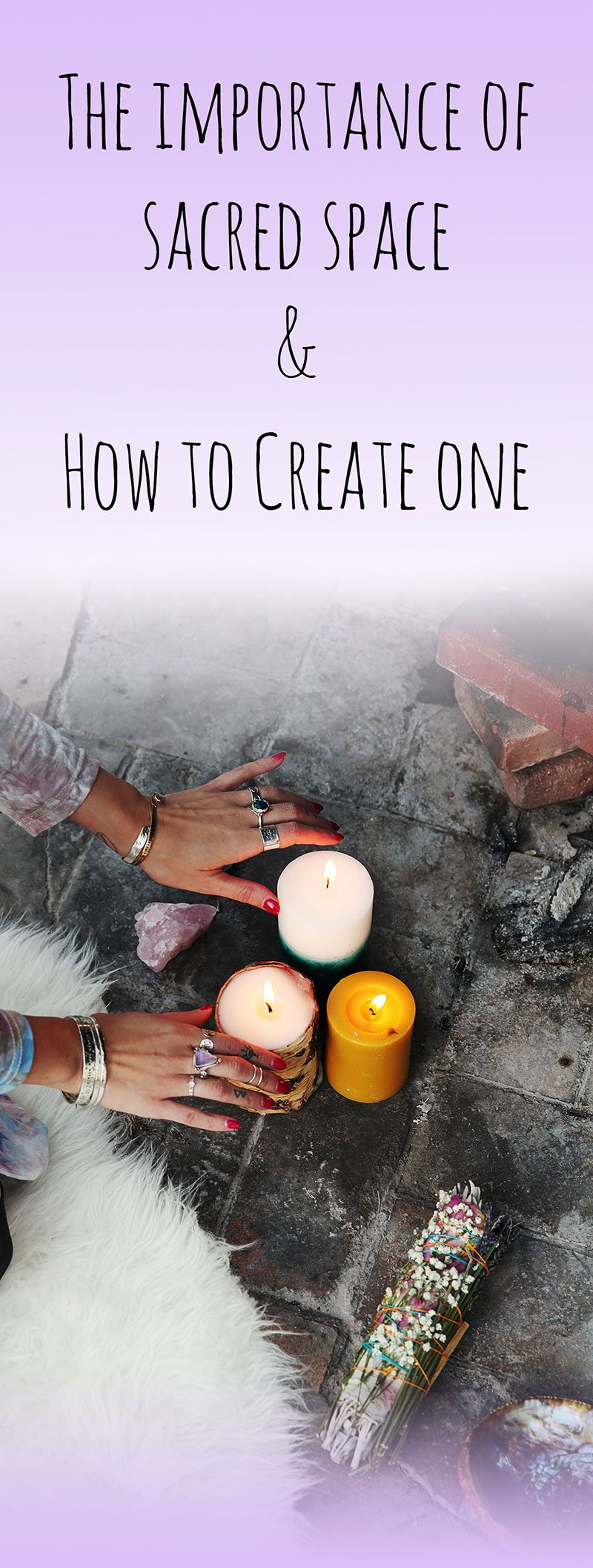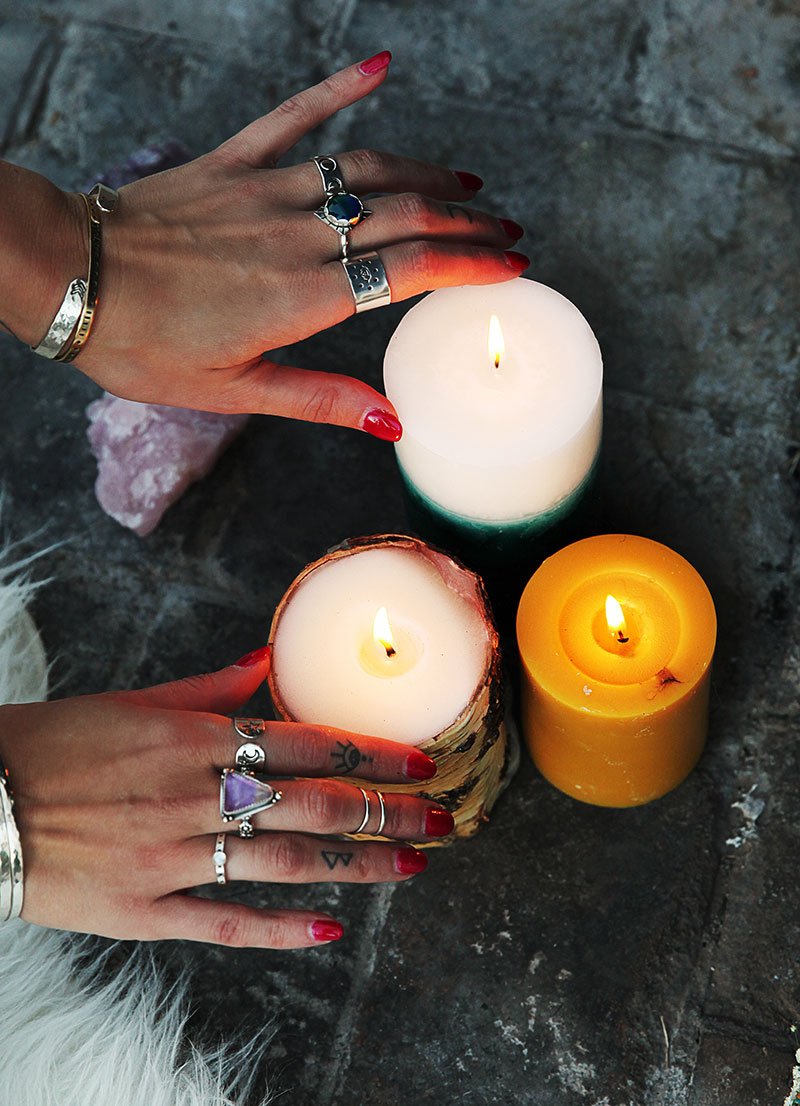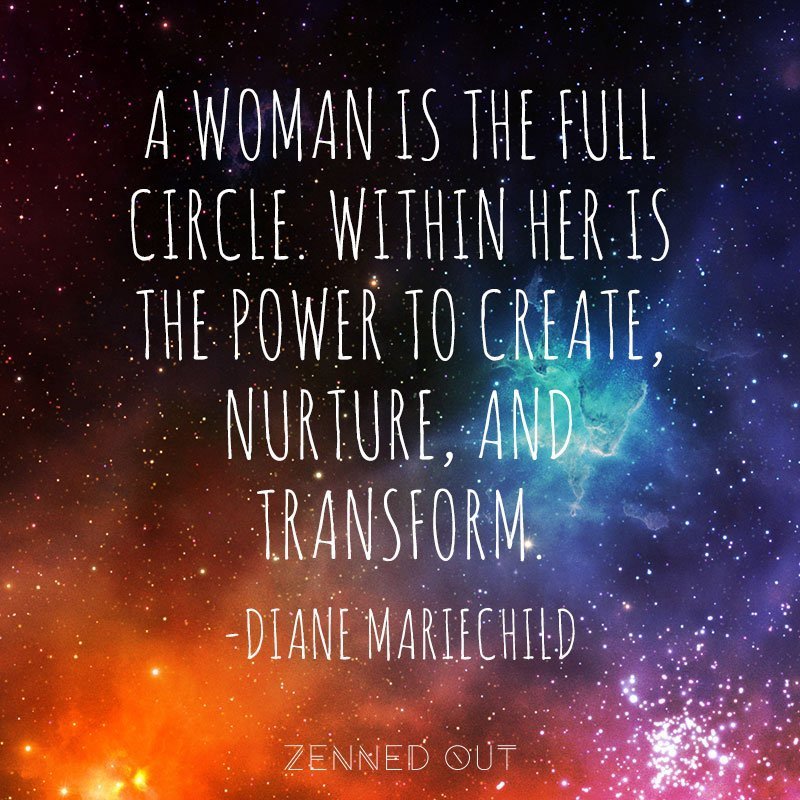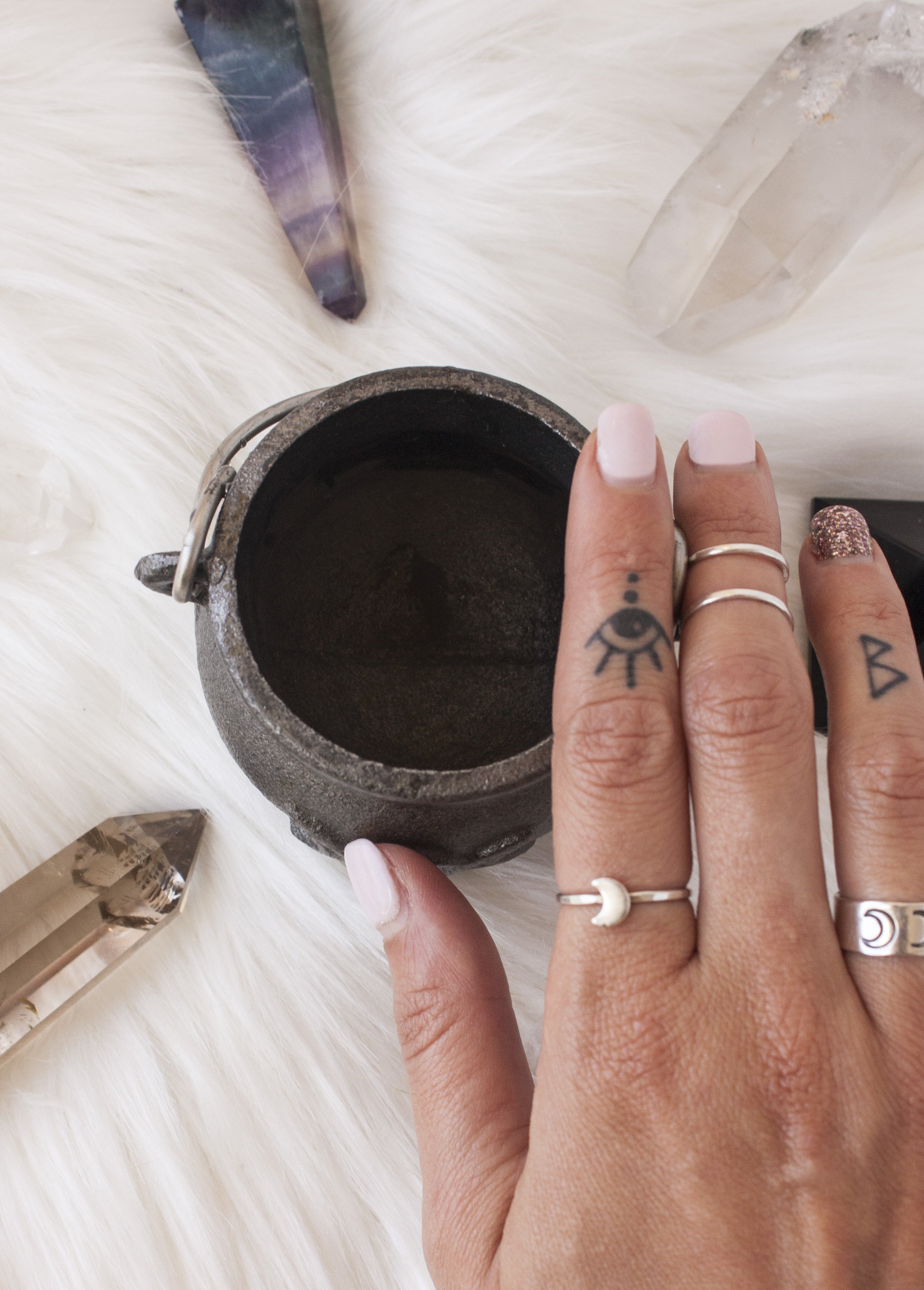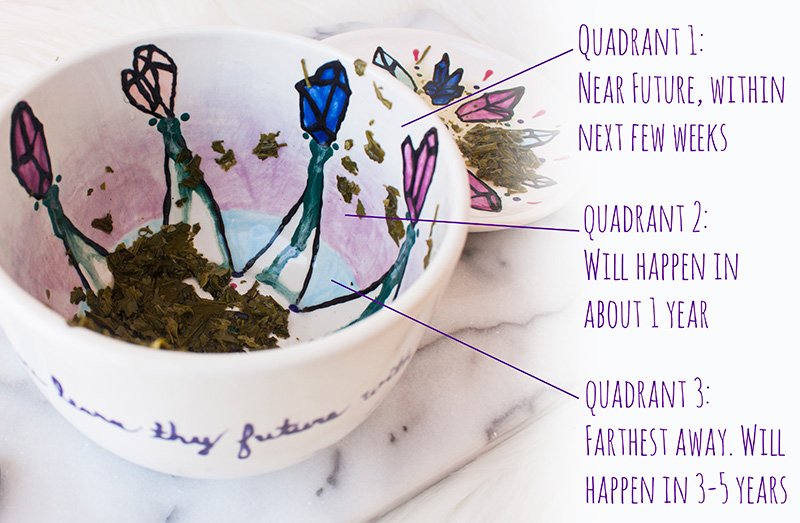What are the 4 Elements and How to Use Them
The four elements are present all around and within you. They are essential to all life. You and the universe are formed by these four elements: earth, air, water, fire. These elements go beyond the physical and manifest as personality traits and energetic forces too.The elements are here to bring balance. Fire needs water to be quenched and the earth needs wind to move it. Your personality might contain more fire and less water, contributing to specific distinctions in your outlook on life and how you express yourself. The elements of your personality can be balanced just like nature.Each element carries its own set of qualities. No element is inherently bad or good. They each carry an equal amount of positive and negative traits. Check out some of the attributes of each element here.
What are the 4 elements?
The four elements are present all around and within you. They are essential to all life. You and the universe are formed by these four elements: earth, air, water, fire. These elements go beyond the physical and manifest as personality traits and energetic forces too.
The elements are here to bring balance. Fire needs water to be quenched and the earth needs wind to move it. Your personality might contain more fire and less water, contributing to specific distinctions in your outlook on life and how you express yourself. The elements of your personality can be balanced just like nature.
Each element carries its own set of qualities. No element is inherently bad or good. They each carry an equal amount of positive and negative traits.
You can apply the four elements to your life in endless ways. Let’s start with why you’d want to use them!
Why represent the 4 elements?
Balancing your own energy
Did you know that your zodiac sign corresponds with one of the four elements? Check out the chart below to see what element you lean towards based on your sign.
One great way to employ the power of the four elements is to balance your own energy. If you lean towards the earth element you may find that bringing some fire energy into your life may energize you. Try wearing a symbol or object that represents the element you’re needing more of.
Bringing Elemental Energy into your space
Do you live or work in a space that’s really tense or competitive? The energy of the space might be overloaded with fire energy that could really benefit from some balancing water energy. By adding some simple symbols or objects that represent water you may find that the vibe of the space really mellows out.
Magical and ritual practices
Because the four elements are the building blocks of all things, inside and outside of you, they are essential for most rituals and magical practices. Think of them as energetic forces to employ for magical manifesting and ritual. Simply having all four of them represented on your altar or in a sacred space is a powerful balancing force.
How to represent the 4 elements
The four elements can be represented in physical form or non-physical form (a symbol) for different purposes. The symbols and representations of them can be placed in a variety of areas. You can wear them, put them on your altar, on your desk, in your car, or in a room. Here are a few ways that you can represent each of the elements.
Earth
The symbol for Earth element
Earthy stones like jasper, agate, amber, petrified wood, and malachite
Metal and wood objects
Green or brown candle
Plants and flowers
Pentacle
Water
The symbol for the Water element
Vessel of water
Blue candle
Shells, coral, sand dollars, etc.
Moon symbolism
Cauldron or chalice
Fire
The symbol for the Fire element
Burning herbs or incense
Matches or lighter
Fire opal and carnelian
Athame
Air
The symbol for the Air element
Smoke from resin, herbs, or incense
Wand
Yellow candle
Citrine and smoky quartz
Feather
Fan
Butterfly, birds, fairies, or dragonflies
You may have already noticed that many of these overlap. For example, burning herbs can serve for earth (the plant material), air (the smoke), and fire (as it burns). Add in an abalone shell (water) to the mix and you’ve got all four elements represented very easily!
What is the Wheel of the Year?
Learning more about the Wheel of the year will not only help you feel more in-tune with nature, but it will give you rituals to use year-round to connect with yourself and Mother Earth. This topic can seem a little overwhelming when getting started, so I will provide you with a quick overview with this post. I'll cover what the Wheel of the Year is, who uses it, how to use it, and some resources, including a free printable of a wheel that I created.
Learning more about the Wheel of the year will not only help you feel more in-tune with nature, but it will give you rituals to use year-round to connect with yourself and Mother Earth. This topic can seem a little overwhelming when getting started, so I will provide you with a quick overview with this post. I'll cover what the Wheel of the Year is, who uses it, how to use it, and some resources, including a free printable of a wheel that I created. Keep scrolling to read more and find a link to your free copy.
What is the Wheel of the year?
The Wheel of the year is comprised of eight Sabbats or festivals that occur on or around the same day each year. The eight Sabbats include four solar events, i.e., the Summer Solstice, Winter Solstice, Spring Equinox, and Fall Equinox. The remaining four festivals are based on seasonal changes and farming. Here's a rundown of the eight Sabbats, what they align with, and their dates:
Samhain: October 31st - November 1st // Samhain is considered the witch's New Year. It is the third and final harvest season and ends the seasonal Wheel.
The Winter Solstice & Yule: December 21st or 22nd // Winter Solstice
Imbolc: February 1st // Holiday is known as Candlemas, which signifies the first signs of Spring
The Spring Equinox & Ostara: March 20th // Spring Equinox (first day of Spring)
Beltane: April 30th - May 1st // A fire ceremony that signifies the midpoint between Spring and Summer
The Summer Solstice & Litha: June 21st or 22nd // Summer Solstice
Lughnasadh: July 31st - August 1st // Marks the first harvest of the year
The Autumn Equinox & Mabon: September 21st - September 23rd // Fall Equinox
© Cassie Uhl 2015-2025. Please properly credit when sharing.
Who Celebrates the Wheel of the Year?
You don't have to subscribe to a specific religion or label to use or observe the Wheel of the year. Most notably, Wiccans, Pagans, Neo-Pagans, and practicing witches reference the Wheel of the Year for festivals and rituals. If you don't identify with any of these labels, but like to dabble in ritual or spellwork, that's perfectly fine! You'll still be able to find many uses for this powerful tool.
Where did the Wheel originate?
The Wheel of the year is rooted in several cultures and combines festivals from Romans, ancient Greeks, Germanic cultures of northern Europe, and the Celts. It's for this reason that you'll see a variety of names for some of the festivals and differing dates. For example, Lughnasadh also goes by Lammas or Lughnasa, and Litha also goes by Midsummer.
The full Wheel of eight festivals is a relatively new creation that came about in the 1950s. The groups listed above each celebrated some of the eight Sabbats, but the evidence is lacking that any of them celebrated all eight. Combining all eight into a wheel was a way to honor and streamline all of the celebrations that many Pagans and Wiccans hold dear.
How to Celebrate The Wheel of The Year
Learning to implement the Wheel of the Year can feel overwhelming, but the way that you work with it can be as simple or complex as you want it to be. There are countless ways to celebrate each celebration on the Wheel of the Year. Check out the list below for a general list of ways you can enjoy the Wheel of the Year. For specific rituals and celebration suggestions, check out The Goddess Discovery Book V2 or search our blog for the Sabbat you'd like to learn more about.
Spend time outside in nature.
Attend a local celebration or create your own for some or all festivals.
Conduct a ritual for each Sabbat. You can find several ritual examples for each Sabbat by searching the Sabbat on our blog.
Add decor and scents to your house based on the Wheel of the Year.
Cleanse and update your altar or sacred space for each Sabbat.
Cook specific foods for each of the Sabbats.
Enjoy crafts with your Goddess circle or kiddos based around the Sabbats.
Go within and try journaling for each Sabbat.
Perform a unique tarot or oracle card spread.
Here's an example of how I often perform my altar update for a new Sabbat.
Additional Resources
Want to dig deeper into using the Wheel of the Year in your practice? Here are three ways to learn more:
1. Click here for my wheel of the year graphic in my magical printables bundle.
2. Click here to purchase Understanding The Wheel of The Year, which goes into detail about the Wheel of the Year and contains wheel images for both the Northern and Southern hemispheres, rituals, card spreads and journal prompts for each Sabbat.
3. Find links to blog posts specifically for each Sabbat below.
Here are other books that I love about the Wheel of the Year: The Magical Year by Danu Forest, The Great Work by Tiffany Lizac, and The Modern Witchcraft Guide to the Wheel of the Year by Judy Ann Nock.
I hope you find the Wheel of the year as special and magical as I do! It has so many positive and powerful applications to bring life to your sacred practices.
The Importance of Sacred Space & How to Create One
I think of sacred space as being very root chakra related. A sacred space feels like home. It feels safe to do your most vulnerable work and have your deepest breakthroughs there. It feels safe to put your worries, your fears, your joys, your disappointments, everything that you have and are on the altar there.The best part is that you don’t need anyone to hold this sacred space for you. You can hold it for yourself.What is it, exactly? It’s any space that you set aside as sacred or holy. It’s a place where you can meditate, do magic and ritual, and connect to your highest self. This might look like an altar, or it might not.
I think of sacred space as being very root chakra related. A sacred space feels like home. It feels safe to do your most vulnerable work and have your deepest breakthroughs there. It feels safe to put your worries, your fears, your joys, your disappointments, everything that you have and are on the altar there.
The best part is that you don’t need anyone to hold this sacred space for you. You can hold it for yourself.
What is it, exactly? It’s any space that you set aside as sacred or holy. It’s a place where you can meditate, do magic and ritual, and connect to your highest self. This might look like an altar, or it might not. If you are interested in creating your own sacred altar, check out this blog post.
Your space is personal and unique to you. This blog post is all about creating sacred space in your home, but remember that you are sacred, too, and any space you hold for yourself can be a sacred space. Divinity doesn’t have to be experienced just at your altar.
With that being said, here are a few ideas for things you might like to include in your sacred space:
A Window
Having your sacred space by a window can be a beautiful way to connect with nature even from the inside. See the sun, the stars, and feel the breeze right in your space.
A Moon Calendar
Connecting with the phases of the moon can help anchor you and connect you with nature. Having moon ritual cards in your sacred space where you do rituals and other healing practices that you might base around moon cycles is ideal.
Crystals
Crystals can raise the frequency of your space and bring in specific energies you want to work with. The options are endless, but some crystals you might like to have in your sacred space are:
Amethyst to help you connect with your intuition and boost your mood
Clear quartz (the ultimate crystal!), the ultimate healer, balancer, manifestor, and energy amplifier
Rose quartz for heart opening
Labradorite for self-discovery
Citrine to bring in energizing and creative energy
Fluorite to cleanse your aura and draw off negative energy
Obsidian or black tourmaline for grounding
Selenite to access higher guidance and open your crown chakra
Candles
Candles and their colors have all different types of uses. You can use them in spell work, rituals, burning ceremonies, or just to bring some soft light into your space. Here are some different candle color meanings (source):
Blue for harmony, peace, and tranquility
Red for passion and action
White for purifying, cleansing, and clarity
Purple for psychic abilities and spiritual awakening
Yellow for inspiration and creativity
Orange for energizing, joy, and success
Pink for love, compassion, and forgiveness
Green for nature, growth, and fertility
Brown for grounding, Earthy energy
Learn more about candle magick here.
A Feather
You can use your feather to direct the flow of smoke when cleansing with a smoke wand or herb. For example, when cleansing yourself you might want to circle the smoke around the top of your head or other parts of your body. A feather will help you do that!
Plants & Herbs
Plants and herbs have so many practical and magickal uses. You can use herbs in your sacred space for burning or tea-drinking, and you might like to also have dried or fresh flowers, or other plants that you feel connected to.Learn more about herbal magick here.
Essential Oils
Like plants and herbs, essential oils also have many practical and magickal uses. Use them in your sacred space for ritual, to anoint your candles, to assist in meditation, or to massage your body. Some go-tos you might like to have are:
Geranium oil for self-love
Juniper for protection and purification
Cilantro oil for releasing negative energy
Lavender oil for peace and healing
Frankincense and myrrh oil for meditation
Yarrow oil to connect with your psychic abilities
Tarot or Oracle Decks
Your sacred space is the perfect place to keep any divination tools you use such as tarot cards, oracle cards, or runes. Display the card or rune you’re working with at the moment on your altar as a visual reminder of the energy you’re working to create, or the intentions you’re working to manifest.
Visual Representations of Goddesses You’re Working With
This could be a printed photo, a statue, an oracle card, a painting, or another creative representation that resonates with you. Everyone’s needs are different, so choose a goddess that you feel drawn to work with. That likely means that she has a message for you.
Salt Lamp
Salt has been touted for its magical properties for a long time. Practically, having a salt lamp in your space releases negative ions (which actually make you feel good, despite the name!) and detoxifies the air. But magically, salt also purifies and protects against psychic attacks. If you don’t want to go for a lamp, you can also opt for a small bowl of sea salt.
Additional Representations of the Four Elements
You don’t actually need additional representations of the four elements (fire, earth, water, and air), since you likely already have them on your altar. But feel free to add any other elements to your space that you’d like, such as a bowl of water.
Learn more about the four elements here.
Any Sacred Possessions
Anything that feels sacred and holds special meaning to you, even if it doesn’t make sense to anyone else, can also go in your sacred space. Maybe it’s photographs, special objects, or mementos. Whatever it is, feel free to add it.
You can customize your sacred space or altar depending on where you are in life and what you’re trying to manifest. For example, you might create an abundance altar centered around money, photos of abundance goddesses like Lakshmi, tarot cards like the 10 of pentacles, and herbs or spices that promote abundance when you want to manifest material wealth.
The most important thing to remember is that this space is for you. All of the above are just options and suggestions. Create a space that feels sacred to you, and you will have created a sacred space.
Manifesting with Runes // With Free Rune Printable
Being a master manifestor is a skill that many seek. There are endless techniques and tools available when it comes to manifesting like a pro and I’m sure you’ve tried some of them. Dream boards, visualization, mantras, and crystals are a few popular manifesting tools.While there’s nothing wrong with these techniques, there’s one powerful manifesting tool that’s often overlooked, Runes.Runes are symbols that each carry unique universal energy. These special symbols were used by Nordic and Germanic cultures in Northern Europe as forms of language, for religious purposes, and as tools of magick and divination.Author Lisa Peschel explains this in her book, A Practical Guide to The Runes.
Being a master manifestor is a skill that many seek. There are endless techniques and tools available when it comes to manifesting like a pro and I’m sure you’ve tried some of them. Dream boards, visualization, mantras, and crystals are a few popular manifesting tools.
While there’s nothing wrong with these techniques, there’s one powerful manifesting tool that’s often overlooked, Runes.
Runes are symbols that each carry unique universal energy. These special symbols were used by Nordic and Germanic cultures in Northern Europe as forms of language, for religious purposes, and as tools of magick and divination.
Author Lisa Peschel explains this in her book, A Practical Guide to The Runes.
Before this time [being used as a form of language] runes were primarily a magickal system of pictographs representing the forces and objects in Nature. It was believed that by calling upon the appropriate rune one could thereby make contact with the force in Nature the symbol represented.
Each Runic symbol creates a specific type of energy and some lend themselves to manifesting more than others. Here’s a list of the most powerful manifesting Runes and what they’re most aligned with manifesting.
Search this list to identify the perfect Rune(s) to aid your current manifesting project!
The Best Runes for Manifesting
Fehu for abundance:This fast-acting Rune is perfect for helping you manifest wealth. It is great for initiating new monetary ventures and circulating abundance.
Uruz to keep you going: Employ the use of Uruz to bolster your strength and remove self-doubt during manifesting. This Rune will also help you with stamina while manifesting goals that take more time
Thurisaz for change: The original meaning of this Rune is “thorn” so it’s not surprising that the meaning of it is all about breaking through. Use this Rune when you’re working on manifesting big changes in your life and you need a powerful and directive catalyst. This Rune can also help you overcome blocks while manifesting.
Gebo for partnerships:This Rune is all about manifesting partnerships. That could be friendships, business relationships, relationships, or marriage. Gebo helps create a balance of energy and is all about equal exchanges. Use this Rune anytime you’re manifesting goals include working with others.
Wunju for happiness: Looking to manifest some more peace and harmony in your life? Wunjo is your Rune! Wunjo is a beautifully powerful Rune that’s great at helping you fulfill wishes, peace, joy, and happiness.
Jara for material objects: If you have your manifesting eye on a material object that requires specific steps to acquire Jera is your Rune. Jera is a great aid for turning dreams into tangible results.
Teiwaz to win: This Rune is all about being victorious. If you’re in the process of manifesting a specific outcome this Rune will be helpful, especially when it comes to competitions. This Rune seeks justice.
Berkana for creation: My personal favorite! Berkano is here to help you birth your big ideas into reality. Recruit Berkano to help lay the fertile ground needed while manifesting new ideas.Now that you know which Runes are your manifesting besties, here are some key ways to work them into your manifesting toolbox. These methods pair perfectly with other manifesting tools mentioned above, so don’t be afraid to mix them up. Already have a vision board for a manifesting project? Put a bird on it! Just kidding, we’ll be using Runes today ;)
Need some Runes to get going? Click here to get your free printable Rune sheet.
5 Ways to Use Runes for Manifesting
1. Put your manifesting Rune in a visible area like your altar, meditation space, bathroom mirror, or on a vision board.
2. Carve your manifesting Rune into a candle that you light regularly as a reminder of what you’re working on manifesting.
3. Wear a Rune talisman. Having a daily wearable reminder is a powerful way to not only be reminded of your manifesting goals but carry the potent power of the Runes with you.
4. Create a Runescript. Linking Runes together in a specific order can have a positive effect on your end results. Learn more about creating a Runescript here.
5. Visualize or meditate on the rune(s) that you’re working with. Hold the image of the Rune you’re using in your mind's eye and try to embody its energy as you meditate or visualize.
If you’ve been unsure about how to use Runes in the past I hope you’re feeling excited to jump in now! Put these powerful symbols to use and start manifesting.
The Divine Feminine & Cauldrons // 5 Uses & Meanings
What do you think of when you imagine a cauldron? Witches, Halloween, and deathly potions perhaps? Along with witches, cauldrons have been given a bad rap, but their mystical meanings and uses go way back and might have a more spiritual meaning than you originally thought!If you’re always on the hunt for meaningful additions to your altar, search no more, the cauldron is a staple and I’m going to share 5 reasons why. First I want to share some history behind its use so you have a complete understanding of what it represents.
What do you think of when you imagine a cauldron? Witches, Halloween, and deathly potions perhaps? Along with witches, cauldrons have been given a bad rap, but their mystical meanings and uses go way back and might have a more spiritual meaning than you originally thought!
If you’re always on the hunt for meaningful additions to your altar, search no more, the cauldron is a staple and I’m going to share 5 reasons why. First I want to share some history behind its use so you have a complete understanding of what it represents.
History of Cauldrons
Cauldrons of varying types can be traced back to a variety of cultures. In fact, one found in Denmark has been traced back to between 200 BC and 300 AD. So basically, they’ve been around for a long ass time.
No surprise, cauldrons started out as a cooking tool. Warm soups and stews were concocted in them to give nourishment to families. They were the heart of the home and life-giving in cold seasons. As cauldrons became more commonplace and important to families, mothers and grandmothers started using them for healing herbal blends and eventually potions.
Cauldrons & The Divine Feminine
After being used for centuries as a cooking and healing tool, cauldrons started to take on more sacred and magical meanings. The cauldron began to represent the Goddess, the Sacred Divine, and a vessel for transformation, healing, and abundance.
The timing of when cauldrons started to be viewed as magical tools is unknown but the reasons why are obvious. The cauldron symbolizes life and abundance through nourishment, transformation by turning herbs into healing concoctions, and the shape of the cauldron itself mimics that of an expectant mother. These reasons combined make the cauldron one of the most sacred tools you can add to your arsenal.
What Kind of Cauldron Should You Get?
Before you jump into the meanings and uses of a cauldron, let’s cover what kinds of cauldrons are best to purchase because there’s no shortage of options.
Hands down, the best cauldron to purchase (if you plan on using it for anything other than sitting on a shelf) is a cast-iron cauldron. Pass by anything that says it’s made out of anything other than cast iron or is plated because it won’t last. You can also purchase earth and wear pottery cauldrons that will work well too. If you go with a ceramic cauldron, ensure that it’s food safe before using it for anything you’ll be ingesting.
5 Cauldron Uses & Meanings
At a loss for what to use your life-giving, transformative, and holy cauldron for? Here are 5 ways to put your cauldron to work:
Looking for a way to represent the four elements on your altar? The cauldron has you covered. Placing a cauldron on your altar is an easy way to represent all four elements with one item.
Represent the Four Elements on Your Altar
Earth: The iron the cauldron is made out of represents earth
Water: The water used while cooking in a cauldron represents the water
Fire: A cauldron would traditionally be heated from a fire underneath it which represents fire
Air: The air around and blow on the soup or potion inside represents the air
The elements are purely symbolic for this use, no need to always have a fire burning underneath your cauldron! You can read more about the four elements here.
Incense, Herbs & Burning Rituals
There are several rituals that call for fire and burning. Whether it’s incense, candles, or burning a piece of paper, a cauldron will not only serve as a sacred tool but will also give you a safe tool for ritual fires. Here are a few ways to use your cauldron for any fire-related rituals.
A safe and meaningful receptacle to burn incense, herbs, or a candle for rituals.
Write a letter to your ancestors or lost loved ones and burn it in the altar for them to receive it.
During the waning moon, write down a habit you’re trying to break or something you’re trying to release on a small piece of paper, then burn it in your cauldron.
Create a small fire in your cauldron to represent light or a God or Goddess of light for a ritual.
Transform with the Triple Goddess Cerridwen
Cerridwen is the Welsh Goddess that represents the triple Goddess or the mother, maiden, and crone. She reminds us that life is all about transitions and transformations. Cerridwen is often shown with a cauldron because she brews a magical potion that grants knowledge and inspiration using a cauldron.
Anytime you’re going through a difficult transition place a cauldron on your altar or in your sacred space as a reminder of Cerridwen. As you navigate through your transition take a few minutes daily in front of your cauldron to imagine Cerridwen taking your fears about your transition, putting them in her cauldron, and taking them out transformed into what you need most.
This excerpt from writer Judith Shaw outlines perfectly the magic Cerridwen wants to bring into your life: "When Cerridwen calls your name, know that the need for change is upon you; transformation is at hand. It is time to examine what circumstances in your life no longer serve you. Something must die so that something new and better can be born. Forging these fires of transformation will bring true inspiration into your life."
Divination
Cauldrons can also be used for a variety of divination purposes. The most common being scrying. To use your cauldron for scrying fill your cauldron with water, wait for the surface to become very still, and begin looking for symbolism. To learn more about scrying you can read this post all about scrying, it’s based on using a crystal ball but the techniques are the same as those used for water scrying.
Abundance Ritual
Because cauldrons have been used as life-giving and nourishing tools, they represent abundance and can be incorporated into any abundance rituals you do. The cauldron can represent abundance of all kinds: money, happiness, friends, etc.
If you’re trying to bring more abundance into your life, place your cauldron somewhere you’ll see it regularly. Let its presence serve as a reminder of your goal to bring more abundance into your life. You can incorporate stones, candle colors, or herbs by placing them in or around your cauldron to strengthen your desire for abundance.
Cauldrons are sacred tools that are often overlooked, but I hope the next time you see a kitschy cauldron decoration for Halloween you’ll smile because you have a greater appreciation for it.
Tea Leaf Reading // How to Do Your Own in 7 Steps
Looking for the perfect divination tool to get a glimpse of your future and entertain guests with for Samhain and Halloween? Tea leaf reading, or tasseography is the art of using tea leaves for divination purposes. Many cultures believe that around the end of October the veil between the physical world and the spirit world is thinned, so it’s the best time to perform divination of all kinds.
Looking for the perfect divination tool to get a glimpse of your future and entertain guests with for Samhain and Halloween? Tea leaf reading, or tasseography is the art of using tea leaves for divination purposes. Many cultures believe that around the end of October the veil between the physical world and the spirit world is thinned, so it’s the best time to perform divination of all kinds.
What is Tea Leaf Reading?
Doing a tea leaf reading involves you indulging in a delicious cup of tea and putting your sharp intuitive skills to work. After you enjoy your warm cup of loose leaf tea, you’ll leave the loose tea leaves at the bottom, where some of these leaves will form symbols, each having its own meaning. That’s where your keen intuitive abilities come in! Anyone can see a triangle at the bottom of a teacup, but your job is to intuit what it means for you or the person you’re reading for.
Where Did Tea Leaf Reading Come From?
You might be wondering where this unusual form of divination came from, so here’s a short history about tasseography. Shortly after tea was introduced to Europe, tea leaf reading, as it’s now recognized, was born. Similar divination tools had been used with an assortment of other materials, but tea leaves seemed to be the favorite! The art of tea leaf reading spread through Europe, especially in Gypsy cultures, and is now practiced throughout the world.
What You Need for a Tea Leaf Reading
Tea cup with a wide brim that’s light enough to easily see your tea leaves. There are a variety of specialty tea leaf reading cups available, they are beautiful but unnecessary. I created mine at a local pottery painting studio. Keep it simple, buy your own, or get crafty with it, any option will work!
Saucer
Loose-leaf green or black tea, preferably organic.
Napkins
Pen and paper
Water
Enough time to savor a cup of tea and get lost in the maze of tea leaf symbols!
How to Perform a Tea Leaf Reading
1. Brew Your Tea
Gather all of your materials. Boil your water. Place about a teaspoon of loose tea in your cup. Pour your water in and steep tea to your preference.For the next 3 steps, if you’re doing a reading for someone else, have them do the following steps.
2. Sip & Swirl
Before you take your first sip, gently swirl the tea counterclockwise three times. Sip and enjoy your tea, but don’t drink it all! When there’s about 1 tablespoon of tea left in your cup, swirl it again 3 times counterclockwise and think about or speak your query aloud.
3. Create Your Tea Reading Canvas
Turn your cup upside down onto your saucer to remove the remaining water, allow it a minute or so to drain, then turn it back upright, and you’re ready for reading!
4. Look for Symbols
Look over your loose leaf tea pieces and see if any symbols or shapes jump out to you immediately. Don’t fret if you don’t see anything immediately, similar to scrying with a crystal ball, it can take some time for imagery to form for you. Try looking at the inside of the cup from different directions to see shapes. Keep in mind the images formed are formed from tea leaves, so you will really need to use your imagination!
5. Record & Decipher Your Findings
If you do start to see some shapes, begin writing them down on your piece of paper so you can decipher them later, note wherein the cup they are too. Now you’re ready to decipher your findings! Here’s a guide for the most common symbols found during tea leaf readings:
6. Understand the Timeline
Where your tea leaves are situated in your cup relate to when they will happen. This is why some of the tea leaf reading cups you find have circles inside of them. Timing is broken into thirds as follows:
Bottom third: farthest away from happening, think 3-5 years out.
Middle third: will happen in about a year from now.
Top third: will be happening in the near future, think within the next few weeks.
7. Form Your Reading
Like most divination tools, a honed intuition is key for success, so be sure to lean on any gut instincts as you form the story for your reading. Once you understand the meaning behind the symbols it’s time to put all of the information into a story that makes sense for you or the person you’re doing a reading for.
This divination tool is so much fun to do with friends and family! Setting in on a fall evening with some loved ones and sip, laugh, enjoy, and maybe get a little glimpse at what’s to come.
